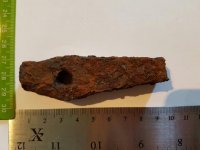Daemonicrising
Tenderfoot
- May 10, 2016
- 6
- 7
- Detector(s) used
- Fisher F19
- Primary Interest:
- All Treasure Hunting
Initially I thought it was just a chuck of metal until I got home and cleaned it up. The field I found it in has a roman Road running through it and there is a Fort and part of the Antonine Wall in nearby fields so I was wondering if it was possibly roman?



 My guess is that's maybe a 150 years give or take stone masons hammer. Mostly just speculation here on my end as I would need to see more angle of it and look for any other comparable hammer heads if in fact that what you have?? .
My guess is that's maybe a 150 years give or take stone masons hammer. Mostly just speculation here on my end as I would need to see more angle of it and look for any other comparable hammer heads if in fact that what you have?? .





 But no more pics to go by, plus the topic is the OP tool head, so guess I best sit it out.
But no more pics to go by, plus the topic is the OP tool head, so guess I best sit it out.


